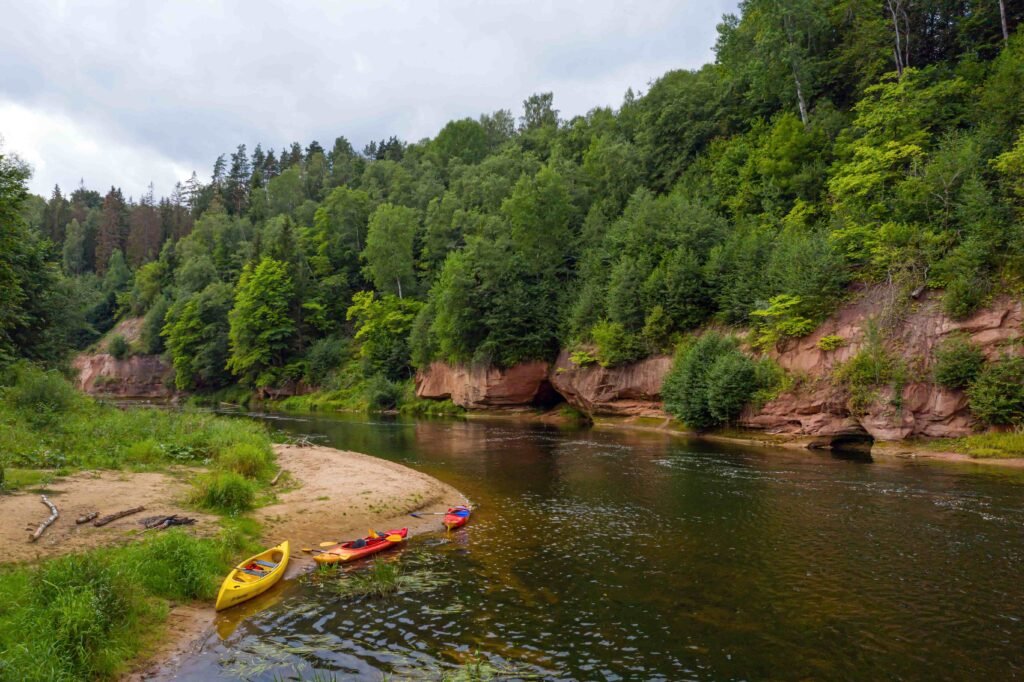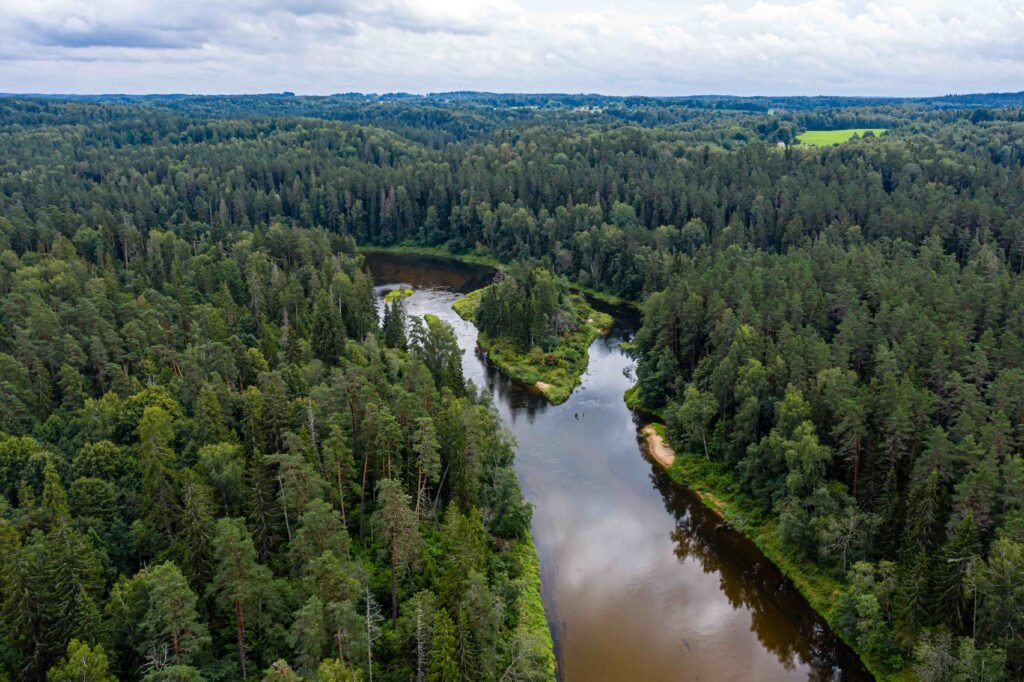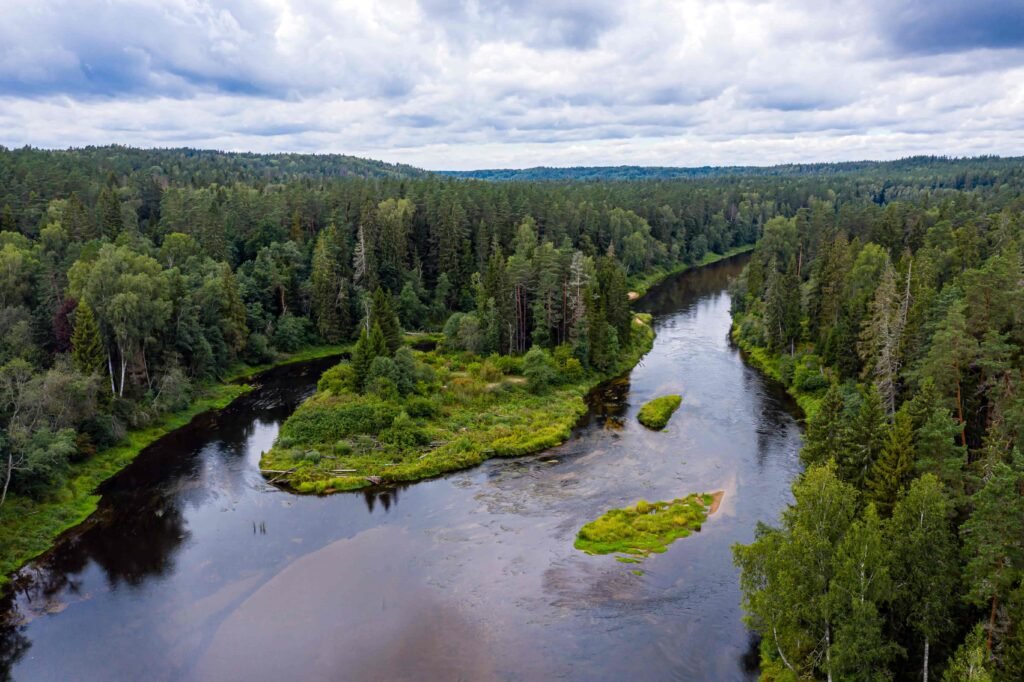
Gauja is a river in the Vidzeme region of Latvia, and the only large river of Latvia that begins and ends its flow in Latvia. Its length is 460 km, of which approximately one-fifth are in the Gauja National Park, the largest and oldest of the national parks in Latvia. The Gauja National Park is characterized by great biological diversity, a variety of landforms, natural springs, sandstone outcrops, picturesque views, and unique natural, cultural, and historical monuments.
Established in 1973, the Gauja National Park stretches over more than 90,000 hectares, protecting the most beautiful section of the Gauja River, which once served as a trading route for the Livonians who built their settlements on its banks. Strong stone castles, which were enclosed by steep slopes and deep valleys, were built in the 13th century. The cities and the social and cultural life grew around the castles, and the area is rich with cultural and historical monuments, including Turaida Castle, Sigulda Castle, and the Gutmanis Cave, which is the largest and oldest cave in Latvia and has been a place of pilgrimage for centuries.
The Gauja National Park offers a wide range of outdoor activities, including hiking, mountain biking, canoeing, and camping. There are many things to see and do in Gauja National Park, including exploring the park’s many trails, taking a cable car ride over the Gauja River Valley, visiting the many cultural and historical sites, and enjoying the park’s natural beauty. Whether you’re looking for a peaceful retreat in nature or an active adventure, Gauja National Park has something for everyone.
Gauja National Park
Gauja National Park is the largest and oldest national park in Latvia. The park was established in 1973 with the purpose of protecting the nation’s most cherished natural landscapes, cultural and historical monuments. The park covers an area of 917.86 km² and is characterized by great biological diversity, variety of landforms, natural springs, sandstone outcrops, picturesque views and unique natural, cultural and historical monuments. The park stretches from north-east of Sigulda to south-west of Cēsis along the valley of the Gauja River, from which the park takes its name.
Nature and Biodiversity
Gauja National Park is home to a diverse range of flora and fauna. The park is covered with forests, which take up around 50% of its territory, and is famous for its forest of virgin pines. The park is also home to many endangered species, including the black stork, lynx, and brown bear. The Gauja River is the lifeblood of the park and is home to a variety of fish species, including salmon and trout.

Activities
Gauja National Park offers visitors a range of outdoor activities. The park has a network of hiking trails, nature trails and walking trails that allow visitors to explore the park’s natural beauty. Visitors can also enjoy canoeing and swimming in the Gauja River. The park also has several camping sites for those who want to spend the night in the great outdoors.
Historical Monuments
Gauja National Park is home to several historical monuments, including stone castles, manors, and art monuments. The park is home to Turaida Castle, a medieval castle that dates back to the 13th century. The castle is one of the most popular tourist attractions in the park and offers visitors a glimpse into Latvia’s rich history. The park is also home to several manor houses and cultural monuments.
Museums
Gauja National Park has several museums that provide visitors with an insight into the park’s history and culture. The Turaida Museum Reserve is one of the most popular museums in the park and is home to a collection of historical artifacts and exhibits. The museum also offers guided tours of the castle and the surrounding area.
Facilities and Fees
Entry to Gauja National Park is free of charge. However, visitors may have to pay an entry fee to visit some of the park’s attractions, such as Turaida Castle and the Secret Soviet Bunker. The park has several facilities, including camping sites, picnic areas, and Latvian saunas.

Day Trip Suggestions
Gauja National Park is an ideal destination for a day trip. Visitors can explore the park’s natural beauty, historical monuments, and cultural attractions. Some of the most popular day trip destinations in the park include Turaida Castle, the Sigulda Bobsleigh and Luge Track, and the Secret Soviet Bunker.
Unique Features
Gauja National Park is unique in many ways. The park is home to a diverse range of flora and fauna, including endangered species. The park also has a rich history and is home to several historical monuments, including stone castles, manors, and art monuments. The park also has several museums that provide visitors with an insight into the park’s history and culture.
Gauja River
The Gauja River is the only large river in Latvia that begins and ends its flow in Latvia. It is 460 km long, of which approximately one-fifth (93.5 km) is in the Gauja National Park. The river is a popular destination for outdoor enthusiasts, offering a range of activities and stunning geological features.
River Activities
The Gauja River is a great location for kayaking and canoeing. There are several rental companies that offer equipment and guided tours. The river is also suitable for swimming, fishing, and boating. The river valley is a popular spot for hiking and cycling, with several trails that offer stunning views of the surrounding sandstone cliffs and outcrops.
Geological Features
The Gauja River flows through the Gauja National Park, which is home to some of the most beautiful sandstone cliffs and outcrops in Latvia. The cliffs rise up to 90 metres above the river, offering breathtaking views of the surrounding landscape. The park also features a number of caves, including Gutmanis Cave, which is the largest cave in the Baltics.
Wildlife
The Gauja River and its surrounding area are home to a variety of mammal species, including beavers, otters, and deer. The river is also a popular spot for birdwatching, with over 150 different species of birds recorded in the area. Visitors to the Gauja National Park may also spot rare and endangered species such as the black stork and the lesser spotted eagle.
In conclusion, the Gauja River is a beautiful and diverse destination that offers a range of activities and stunning geological features. Whether you are interested in kayaking, hiking, or wildlife watching, the Gauja River and its surrounding area have something to offer everyone.

Towns and Cities
Gauja National Park is home to several towns and cities that are worth visiting. Here are some of the most notable ones:
Sigulda
Sigulda is a picturesque town located in the Vidzeme region of Latvia. It is known for its stunning natural surroundings, which include the primeval Gauja river valley and the nearby Gauja National Park. Visitors to Sigulda can take a cable car across the valley to get a bird’s-eye view of the area, or try their hand at bobsleighing at the Sigulda Bobsleigh and Luge Track.
Valmiera
Valmiera is a city in the northern part of Latvia that is known for its rich history and cultural heritage. Visitors to Valmiera can explore the city’s many museums and galleries, or take a stroll through the beautiful Valmiera Park. The city is also home to the Livonian Order Castle, which dates back to the 13th century.
Cēsis
Cēsis is a charming town located in the Vidzeme region of Latvia. It is known for its well-preserved Old Town, which features many historic buildings and landmarks. Visitors to Cēsis can explore the town’s medieval castle, or take a walk through the nearby Gauja National Park.
Līgatne
Līgatne is a small town located in the Gauja River Valley. It is known for its beautiful nature trails, which offer visitors the chance to explore the area’s pristine forests and wildlife. The town is also home to the Līgatne Nature Trails, which feature several hiking routes that range in difficulty from easy to challenging.
Overall, the towns and cities in and around Gauja National Park offer visitors a unique glimpse into Latvia’s rich history and natural beauty. Whether you’re interested in Livonian culture, medieval castles, or pristine forests, there is something for everyone to enjoy in this beautiful region of Latvia.
Outdoor Activities
Gauja National Park offers a wide range of outdoor activities for nature enthusiasts. Hiking and cycling are the most popular activities, but visitors can also go canoeing, rafting, caving, and even bungee jumping.
The park has several hiking trails, ranging from easy to challenging, that offer stunning views of the park’s natural beauty. The Amata Trail is a popular hiking trail that follows the Amata River and leads to several waterfalls. The trail is approximately 15 km long and takes around 4-5 hours to complete.
For those looking for a wilderness experience, the park offers several camping sites where visitors can stay overnight. The camping sites are equipped with basic facilities such as toilets and fire pits.
In addition to outdoor activities, the park also has several cultural and historical monuments to visit. Visitors can explore the Turaida Castle, which dates back to the 13th century, or the Gutmanis Cave, which has the largest rock in Latvia covered in inscriptions.
Overall, Gauja National Park is a paradise for outdoor enthusiasts looking for an adventure in nature.
Gauja Formation
The Gauja Formation is a Middle Devonian fossil locality in Estonia and Latvia. It is named after the Gauja River, where it is exposed along the banks. The formation has a maximum thickness of 80 m (260 ft) and consists of sandstones, siltstones, and shales.
The Gauja Formation is known for its rich and diverse fossil fauna, including trilobites, brachiopods, bryozoans, and corals. The fossils found in the Gauja Formation provide important insights into the evolution of marine life during the Middle Devonian period, approximately 390 million years ago.
The Gauja Formation is also significant for its stratigraphic and paleogeographic implications. The formation is part of the Livonian Basin, a region that was situated on the eastern margin of the paleocontinent of Laurentia during the Middle Devonian. The Livonian Basin was a shallow sea that was separated from the open ocean by a chain of islands. The Gauja Formation represents a transitional environment between the shallow marine and terrestrial environments of the Livonian Basin.
The Gauja Formation is a popular destination for geologists and paleontologists who are interested in studying the Middle Devonian period. The formation is exposed in several locations along the Gauja River, including the Gauja National Park, where visitors can observe the fossils and the geology of the area.
Baltic Region
The Gauja River flows through the Baltic region of Europe, which includes the countries of Estonia, Latvia, and Lithuania. This region is known for its rich history, diverse culture, and stunning natural beauty.
Estonia, located to the north of Latvia, is known for its medieval architecture, picturesque old towns, and beautiful beaches. The country is also home to many islands, forests, and lakes, making it a popular destination for nature lovers.
The Baltic States, including Estonia, Latvia, and Lithuania, are located in north-central Europe, on the eastern coast of the Baltic Sea, and along the western border of the Russian Federation and Belarus. These countries share a common history and culture, and are known for their unique blend of Nordic, Germanic, and Slavic influences.
The region has a long and fascinating history, with evidence of human habitation dating back to the Stone Age. Over the centuries, the region has been ruled by various powers, including the Teutonic Knights, the Swedish Empire, and the Soviet Union.
Today, the Baltic region is a vibrant and dynamic part of Europe, with a thriving economy, rich cultural heritage, and beautiful natural landscapes. Visitors to the region can explore historic cities, enjoy delicious local cuisine, and take in the stunning scenery of the Baltic Sea and the Gauja River.
Whether you are interested in history, culture, or nature, the Baltic region has something to offer everyone. So why not plan your next trip to this beautiful part of Europe and discover all that it has to offer?
Family Activities
Gauja National Park is a great destination for families looking for a fun and educational outdoor adventure. The park offers a wide range of activities that are suitable for all ages, from hiking and cycling to canoeing and bungy jumping. Here are some of the best family-friendly activities that Gauja National Park has to offer:
Hiking and Nature Trails
Gauja National Park is home to over 500 km of hiking trails that wind through the park’s stunning landscapes. Families can explore the park’s forests, rivers, and hills on a leisurely stroll or a more challenging hike. There are trails for all levels of fitness and experience, and many of them are suitable for children.
Canoeing and Rafting
The Gauja River is the perfect place for families to enjoy a day of canoeing or rafting. There are several companies that offer guided tours of the river, which is surrounded by beautiful scenery and wildlife. Families can paddle along the river and stop at one of the many picnic areas along the way for a relaxing lunch.
Caving
Gauja National Park is home to several caves that are open to the public. Families can explore the underground world of the park and discover the unique rock formations and underground rivers. The caves are suitable for children, but younger children may need to be accompanied by an adult.
Cultural and Historical Monuments
Gauja National Park is also home to several cultural and historical monuments that are worth a visit. Families can explore the medieval castles, churches, and manor houses that dot the park’s landscape. The Turaida Castle and the Sigulda Castle are two of the most popular attractions in the park.
Amusement Park
The Tarzan Adventure Park is a great destination for families looking for a fun and exciting day out. The park has several zip lines, rope bridges, and other obstacles that will challenge and entertain children of all ages. There is also a playground for younger children.
In summary, Gauja National Park offers a wide range of family-friendly activities that are sure to please everyone. Families can explore the park’s stunning landscapes, discover its cultural and historical treasures, and enjoy a day of adventure and fun.




